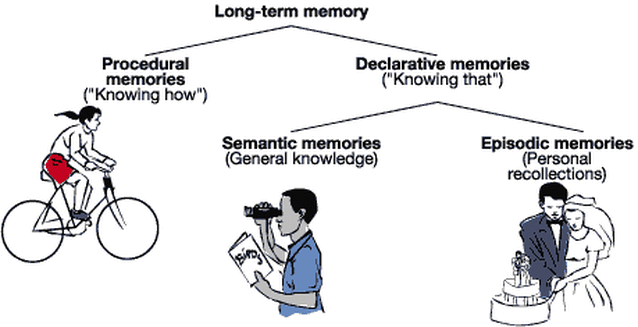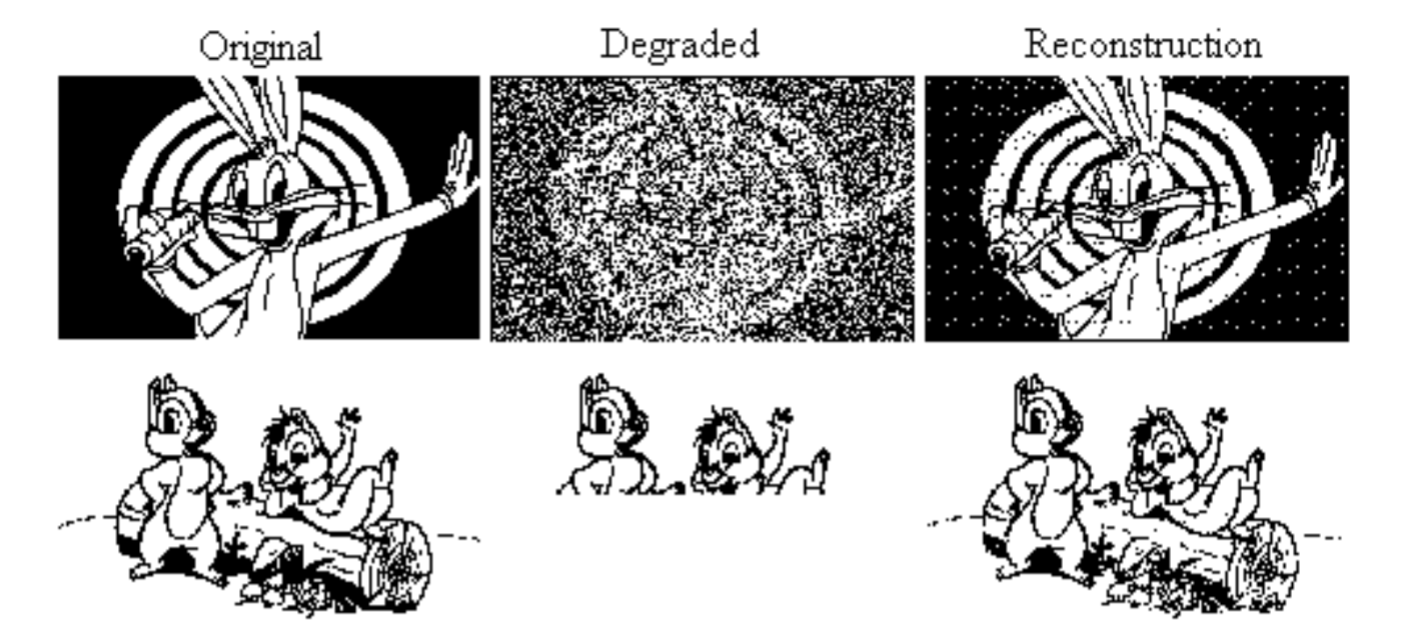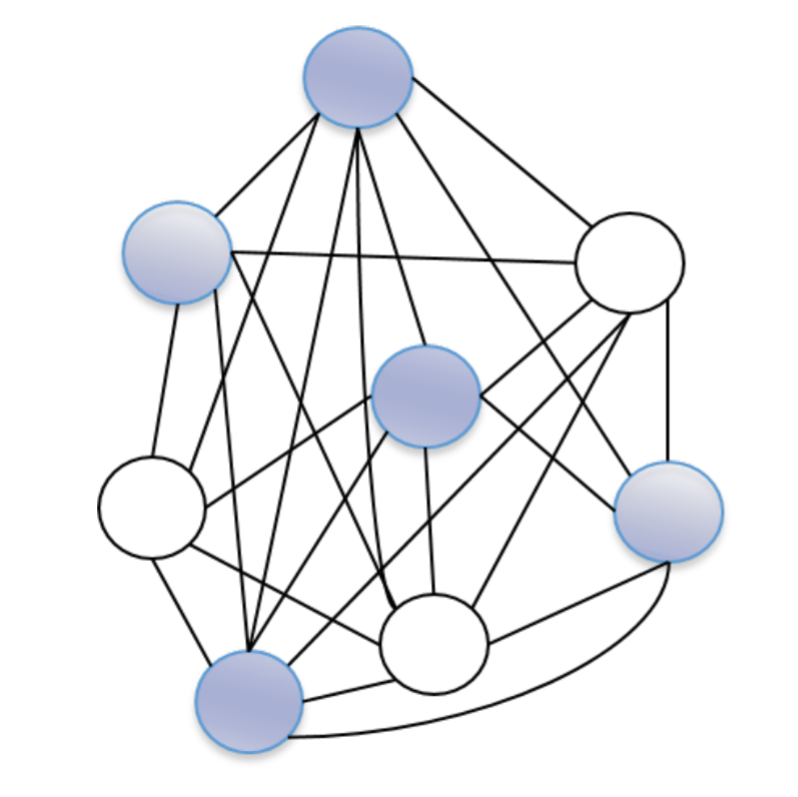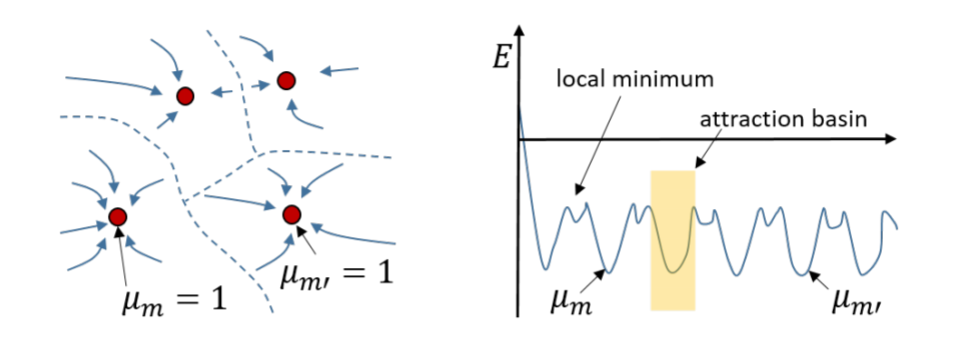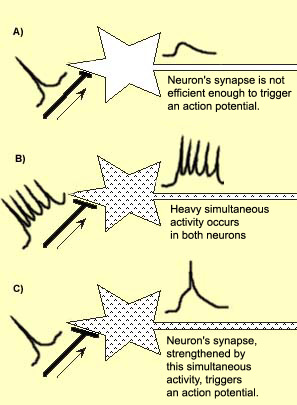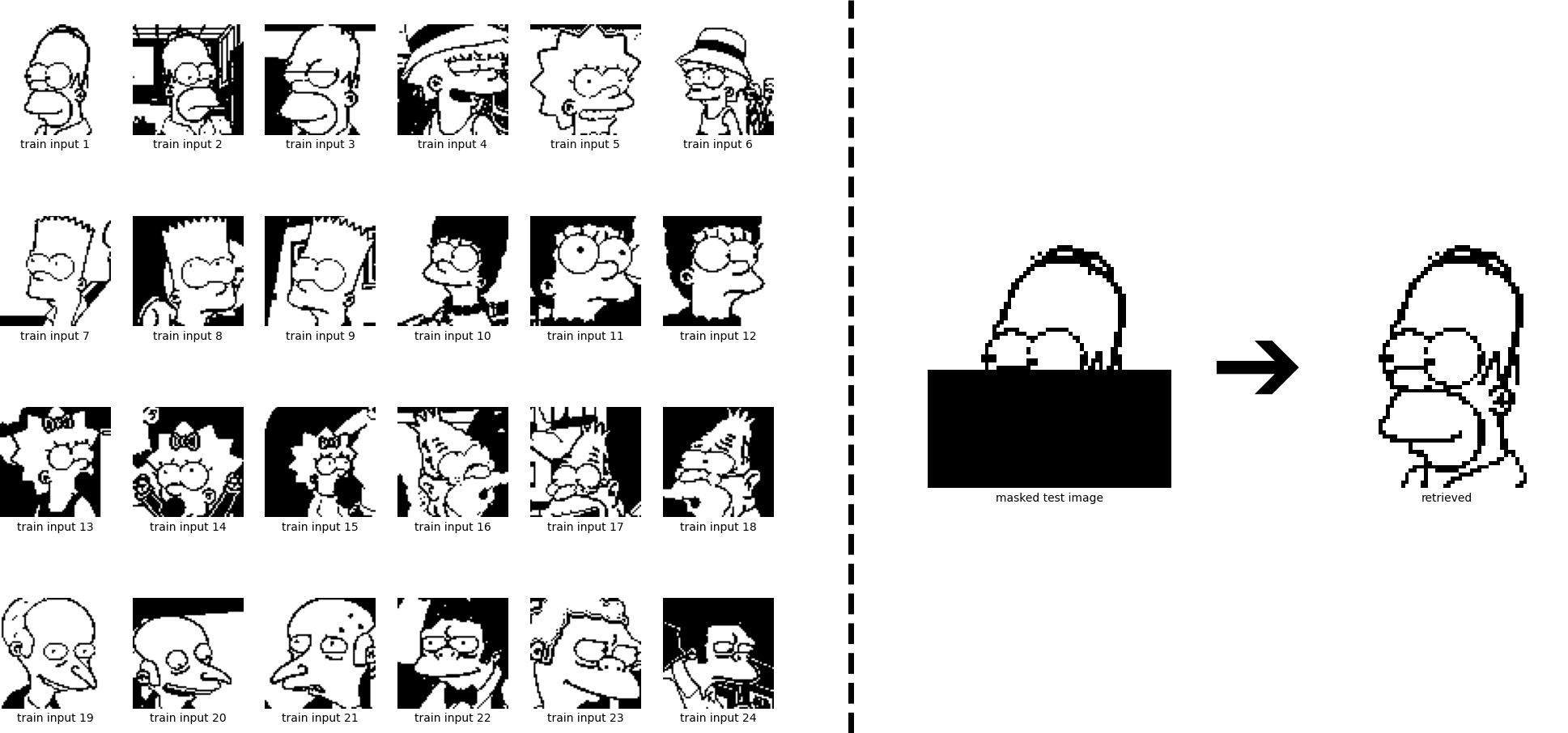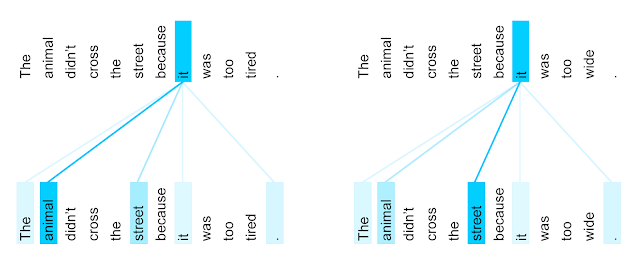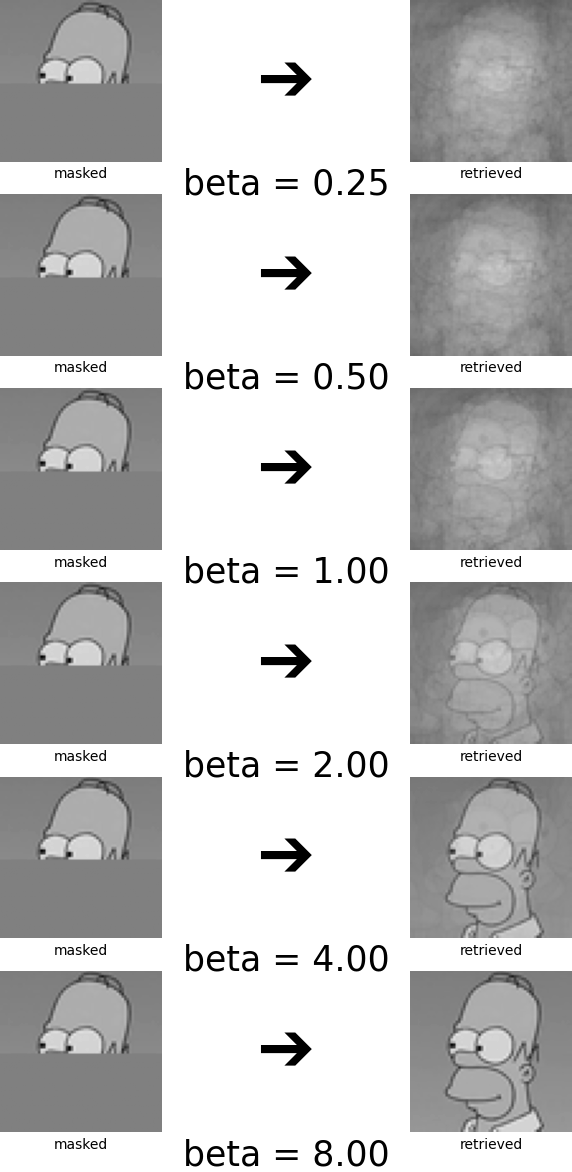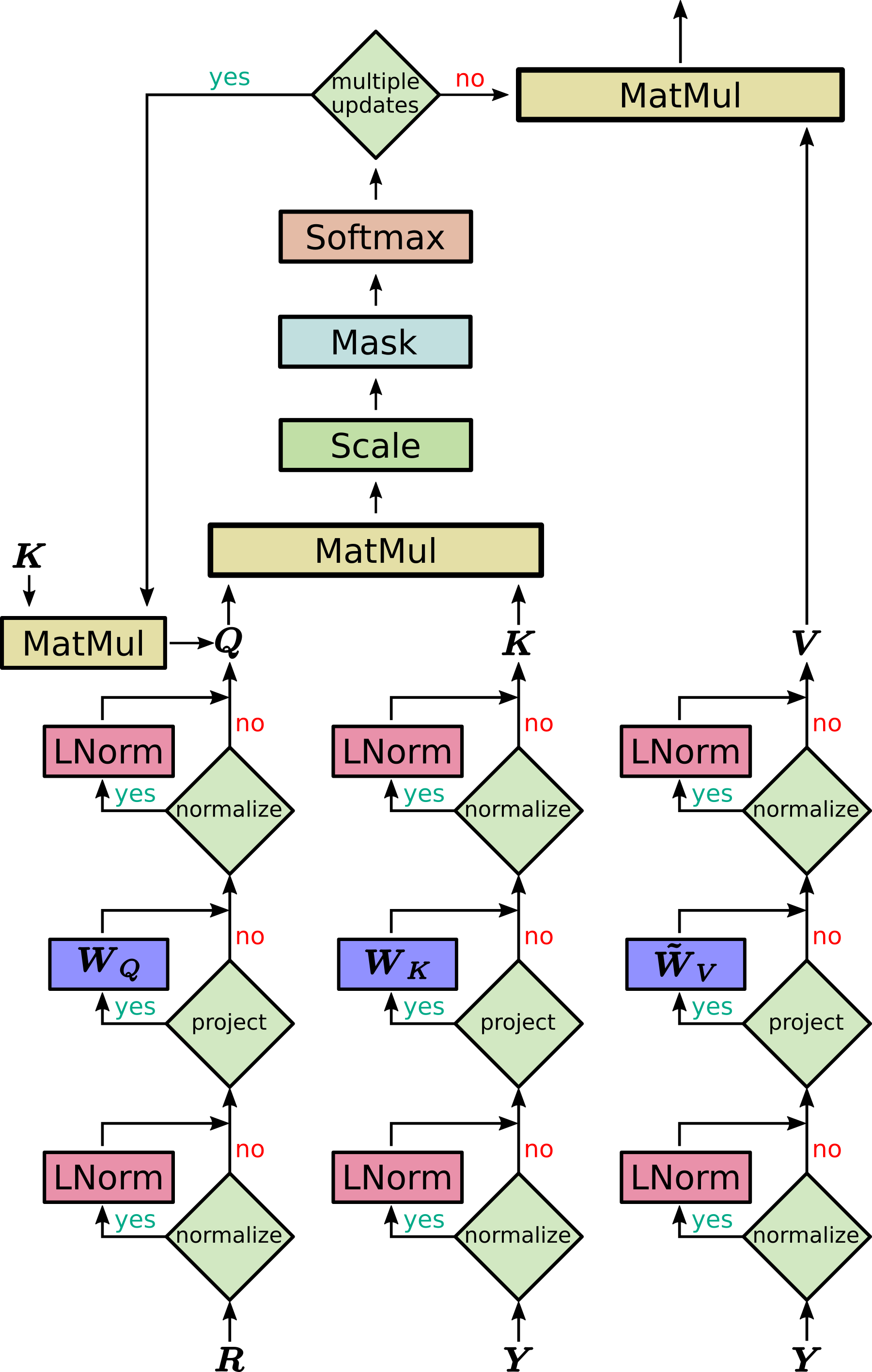Neurocomputing
Hopfield networks
Professur für Künstliche Intelligenz - Fakultät für Informatik
1 - Associative memory
Procedural vs. episodic memory
In deep learning, our biggest enemy was overfitting, i.e. learning by heart the training examples.
But what if it was actually useful in cognitive tasks?
Deep networks implement a procedural memory: they know how to do things.
A fundamental aspect of cognition is episodic memory: remembering when specific events happened.
When can episodic memory be useful?
Episodic memory is particularly useful when retrieving memories from degraded or partial inputs.
When the reconstruction is similar to the remembered input, we talk about auto-associative memory.
An item can be retrieved by just knowing part of its content: content-adressable memory.
Auto-associative memory
Hmunas rmebmeer iamprtnot envtes in tiher leivs. You mihgt be albe to rlecal eervy deiatl of yuor frist eaxm at cllgeoe; or of yuor fsirt pbuilc sepceh; or of yuor frsit day in katigrneedrn; or the fisrt tmie you wnet to a new scohol atefr yuor fimlay mveod to a new ctiy. Hmaun moemry wkors wtih asncisoatois. If you haer the vicoe of an old fernid on the pnohe, you may slntesnoauopy rlaecl seortis taht you had not tghuoht of for yares. If you are hrgnuy and see a pcturie of a bnaana, you mihgt vdivliy rclael the ttsae and semll of a bnanaa and teerbhy rieazle taht you are ideend hngury. In tihs lcterue, we peesrnt modles of nrueal ntkweros taht dbriecse the rcaell of puielovsry seortd imtes form mmorey.
Text scrambler by http://www.stevesachs.com/jumbler.cgi
Auto-associative memory
The classical approach is the nearest neighbour algorithm.
One compares a new input to each of the training examples using a given metric (distance) and assigns the input to the closest example.
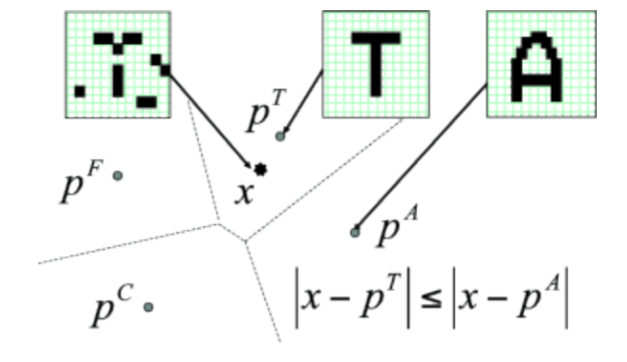
- Another approach is to have a recurrent neural network memorize the training examples and retrieve them given the input.
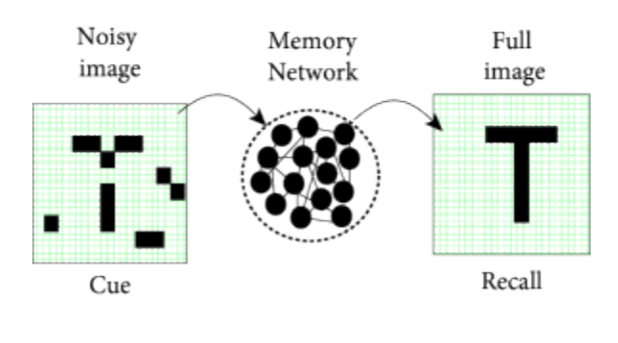
Hetero-associative memory
When the reconstruction is different from the input, it is an hetero-associative memory.
Hetero-associative memories often work in both directions (bidirectional associative memory):
- name \leftrightarrow face.

2 - Hopfield networks
Feedforward and recurrent neural networks
- Feedforward networks only depend on the current input:
\mathbf{y}_t = f(W \times \mathbf{x}_t + \mathbf{b})
- Recurrent networks also depend on their previous output:
\mathbf{y}_t = f(W \times [\mathbf{x}_t \, ; \, \mathbf{y}_{t-1}] + \mathbf{b})
- Both are strongly dependent on their inputs and do not have their own dynamics.
Hopfield networks
- Hopfield networks (Hopfield, 1982; Hopfield et al., 1983) only depend on a single input (one constant value per neuron) and their previous output using recurrent weights:
\mathbf{y}_t = f(\mathbf{x} + W \times \mathbf{y}_{t-1} + \mathbf{b})
For a single constant input \mathbf{x}, one lets the network converge for enough time steps T and observe what the final output \mathbf{y}_T is.
Hopfield network have their own dynamics: the output evolves over time, but the input is constant.
One can even omit the input \mathbf{x} and merge it with the bias \mathbf{b}: the dynamics will only depend on the initial state \mathbf{y}_0.
\mathbf{y}_t = f(W \times \mathbf{y}_{t-1} + \mathbf{b})
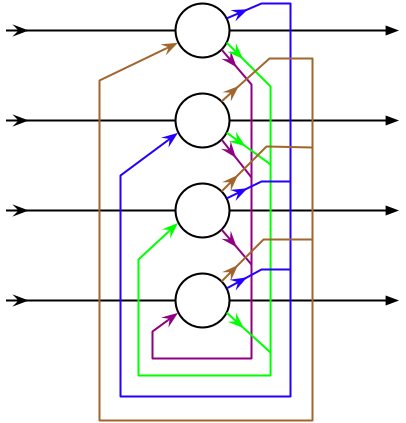
Hopfield networks
Binary Hopfield networks use binary units.
The neuron i has a net activation x_i (potential) depending on the other neurons j through weights w_{ji}:
x_i = \sum_{j \neq i} w_{ji} \, y_j + b
- The output y_i is the sign of the potential:
y_i = \text{sign}(x_i)
\text{sign}(x) = \begin{cases} +1 \; \text{if} \, x>0 \\ -1 \; \text{otherwise.}\end{cases}
There are no self-connections: w_{ii} = 0.
The weights are symmetrical: w_{ij} = w_{ji}.
- In matrix-vector form:
\mathbf{y} = \text{sign}(W \times \mathbf{y} + \mathbf{b})
Hopfield networks
At each time step, a neuron will flip its state if the sign of the potential x_i = \sum_{j \neq i} w_{ji} \, y_j + b does not match its current output y_i.
This will in turn modify the potential of all other neurons, who may also flip. The potential of that neuron may change its sign, so the neuron will flip again.
After a finite number of iterations, the network reaches a stable state (proof later).
Neurons are evaluated one after the other: asynchronous evaluation.
Hopfield networks
Let’s consider a Hopfield network with 5 neurons, sparse connectivity and no bias.
In the initial state, 2 neurons are on (+1), 3 are off (-1).

Hopfield networks
Let’s evaluate the top-right neuron.
Its potential is -4 * 1 + 3 * (-1) + 3 * (-1) = -10 < 0. Its output stays at -1.
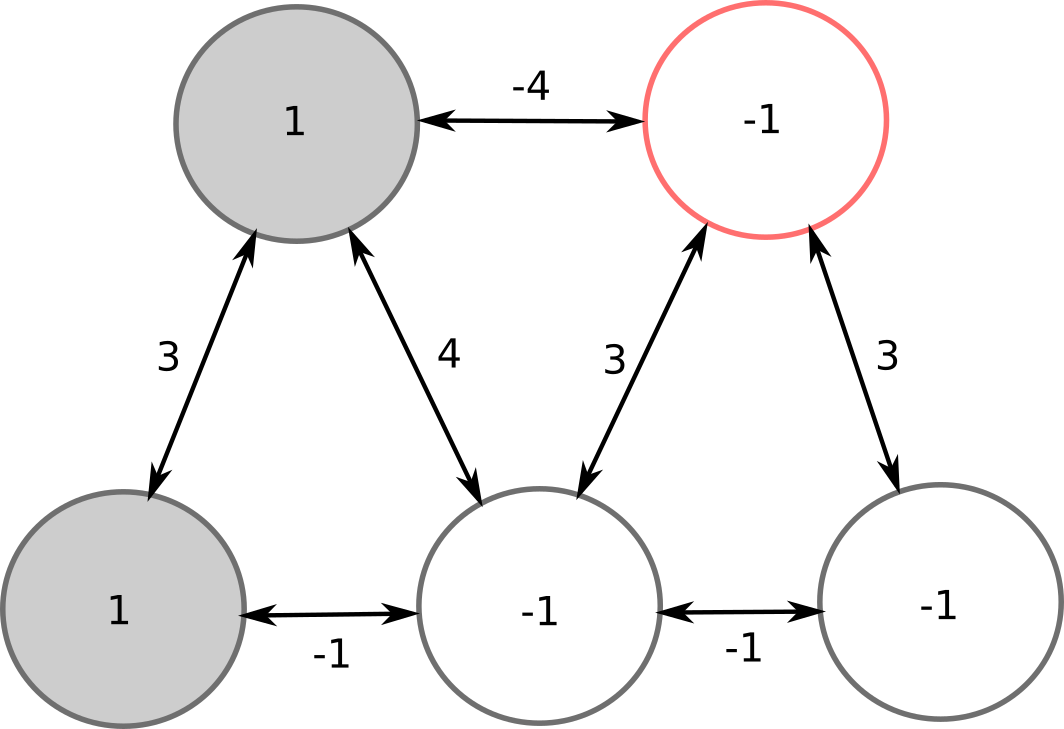
Hopfield networks
Now the bottom-left neuron.
The same: 3 * 1 + (-1) * (-1) = 4 > 0, the output stays at +1.
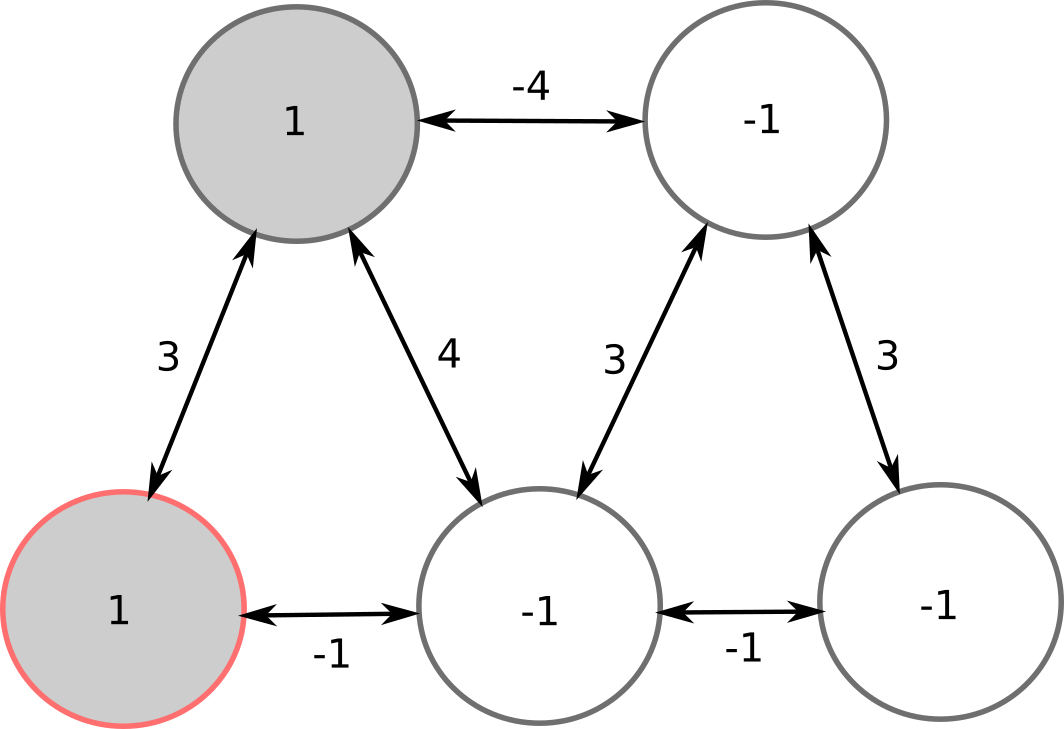
Hopfield networks
But the bottom-middle neuron has to flip its sign: -1 * 1 + 4 * 1 + 3 * (-1) - 1 * (-1) = 1 > 0.
Its new output is +1.
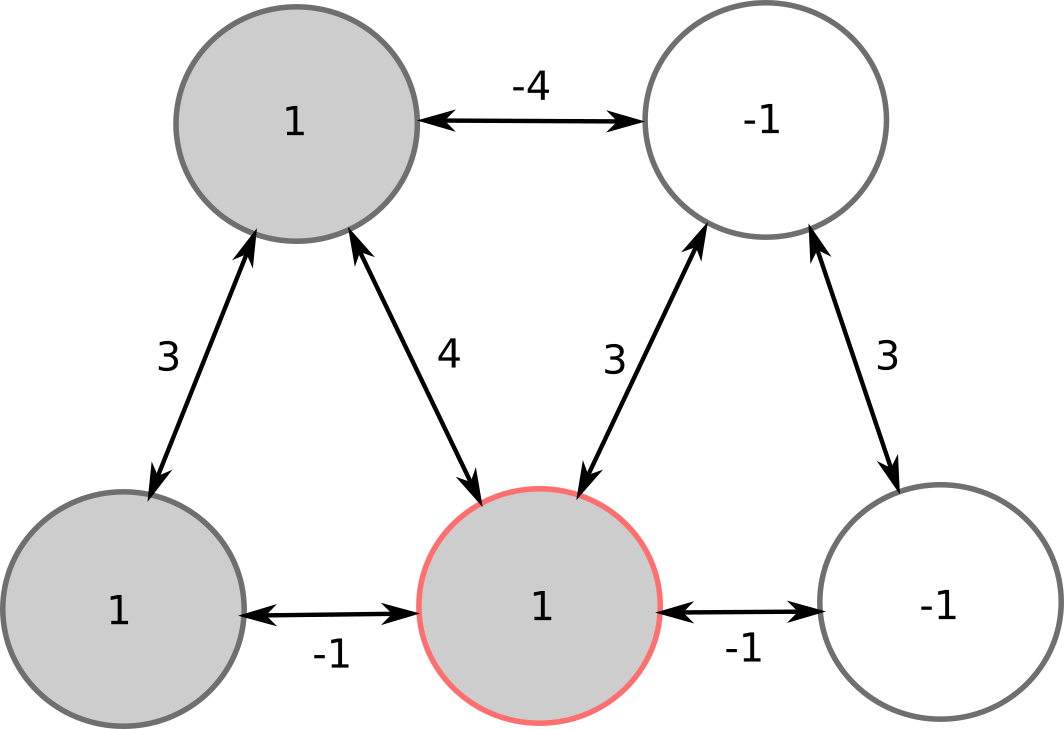
Hopfield networks
We can continue evaluating the neurons, but nobody will flip its sign.
This configuration is a stable pattern of the network.

Hopfield networks
There is another stable pattern, where the two other neurons are active: symmetric or ghost pattern.
All other patterns are unstable and will eventually lead to one of the two stored patterns.

Hopfield networks


The weight matrix W allows to encode a given number of stable patterns, which are fixed points of the network’s dynamics.
Any initial configuration will converge to one of the stable patterns.
Hopfield networks
Initialize a symmetrical weight matrix without self-connections.
Set an input to the network through the bias \mathbf{b}.
while not stable:
Pick a neuron i randomly.
Compute its potential:
x_i = \sum_{j \neq i} w_{ji} \, y_j + b
- Flip its output if needed:
y_i = \text{sign}(x_i)
Asynchronous evaluation
Why do we need to update neurons one by one, instead of all together as in ANNs (vector-based)?
Consider the two neurons below:

- If you update them at the same time, they will both flip:

- But at the next update, they will both flip again: the network will oscillate for ever.

Asynchronous evaluation
- By updating neurons one at a time (randomly), you make sure that the network converges to a stable pattern:



Energy of the Hopfield network
Let’s have a look at the quantity y_i \, (\sum_{j \neq i} w_{ji} \, y_j + b) before and after an update:
If the neuron does not flip, the quantity does not change.
If the neuron flips (y_i goes from +1 to -1, or from -1 to +1), this means that:
y_i and \sum_{j \neq i} w_{ji} \, y_j + b had different signs before the update, so y_i \, (\sum_{j \neq i} w_{ji} \, y_j + b) was negative.
After the flip, y_i and \sum_{j \neq i} w_{ji} \, y_j + b have the same sign, so y_i \, (\sum_{j \neq i} w_{ji} \, y_j + b) becomes positive.
The change in the quantity y_i \, (\sum_{j \neq i} w_{ji} \, y_j + b) is always positive or equal to zero:
\Delta [y_i \, (\sum_{j \neq i} w_{ji} \, y_j + b)] \geq 0
- No update can decrease this quantity.
Energy of the Hopfield network
- Let’s now sum this quantity over the complete network and reverse its sign:
E(\mathbf{y}) = - \sum_i y_i \, (\sum_{j > i} w_{ji} \, y_j + b)
- We can expand it and simplify it knowing that w_{ii}=0 and w_{ij} = w_{ji}:
E(\mathbf{y}) = - \frac{1}{2} \, \sum_{i, j} w_{ij} \, y_i \, y_j - \sum_j y_j \, b_j
The term \frac{1}{2} comes from the fact that the weights are symmetric and count twice in the double sum.
In a matrix-vector form, it becomes:
E(\mathbf{y}) = -\frac{1}{2} \, \mathbf{y}^T \times W \times \mathbf{y} - \mathbf{b}^T \times \mathbf{y}
E(\mathbf{y}) is called the energy of the network or its Lyapunov function for a pattern (\mathbf{y}).
We know that updates can only decrease the energy of the network, it will never go up.
Moreover, the energy has a lower bound: it cannot get below a certain value as everything is finite.
Energy of the Hopfield network
- The energy of the network can only decrease but has a lower bound.
E(\mathbf{y}) = -\frac{1}{2} \, \mathbf{y}^T \times W \times \mathbf{y} - \mathbf{b}^T \times \mathbf{y}
- Stable patterns are local minima of the energy function: no update can increase the energy.
Energy of the Hopfield network
Stable patterns are point attractors.
Other patterns have higher energies and are attracted by the closest stable pattern (attraction basin).
Capacity of a Hopfield network

- It can be shown that for a network with N units, one can store up to 0.14 N different patterns:
C \approx 0.14 \, N
If you have 1000 neurons, you can store 140 patterns.
As you need 1 million weights for it, it is not very efficient…
McEliece et al. (1987) The capacity of the Hopfield associative memory. IEEE Transactions on Information Theory 33:461–482. doi:10.1109/TIT.1987.1057328
Storing patterns
- The weights define the stored patterns through their contribution to the energy:
E = -\frac{1}{2} \, \mathbf{y}^T \times W \times \mathbf{y} - \mathbf{b}^T \times \mathbf{y}
How do you choose the weights W so that the desired patterns (\mathbf{y}^1, \mathbf{y}^2, \dots, \mathbf{y}^P) are local minima of the energy function?
Let’s omit the bias for a while, as it does not depend on W. One can replace the bias with a weight to a neuron whose activity is always +1.
The pattern \mathbf{y}^1 = [y^1_1, y^1_2, \ldots, y^1_N]^T is stable if no neuron flips after the update:
y^1_i = \text{sign}(\sum_{j\neq i} w_{ij} \, y^1_j) \; \; \forall i
- Which weights respect this stability constraint?
Hebb’s rule: Cells that fire together wire together
When an axon of cell A is near enough to excite a cell B and repeatedly or persistently takes part in firing it, some growth process or metabolic change takes place in one or both cells such that A’s efficiency, as one of the cells firing B, is increased.
Donald Hebb, 1949
Hebbian learning
Hebbian learning between two neurons states that the synaptic efficiency (weight) of their connection should be increased if the activity of the two neurons is correlated.
The correlation between the activities is simply the product:
\Delta w_{i,j} = y_i \, y_j
If both activities are high, the weight will increase.
If one of the activities is low, the weight won’t change.
It is a very rudimentary model of synaptic plasticity, but verified experimentally.
Storing patterns
- The fixed point respects:
y^1_i = \text{sign}(\sum_{j\neq i} w_{ij} \, y^1_j) \; \; \forall i
- If we use w_{i,j} = y^1_i \, y^1_j as the result of Hebbian learning (weights initialized at 0), we obtain
y^1_i = \text{sign}(\sum_{j\neq i} y^1_i \, y^1_j \, y^1_j) = \text{sign}(\sum_{j\neq i} y^1_i) = \text{sign}((N-1) \, y^1_i) = \text{sign}(y^1_i) = y^1_i \; \; \forall i
as y^1_j \, y^1_j = 1 (binary units).
This means that setting w_{i,j} = y^1_i \, y^1_j makes \mathbf{y}^1 a fixed point of the system!
Remembering that w_{ii}=0, we find that W is the correlation matrix of \mathbf{y}^1 minus the identity:
W = \mathbf{y}^1 \times (\mathbf{y}^1)^T - I
(the diagonal of \mathbf{y}^1 \times (\mathbf{y}^1)^T is always 1, as y^1_j \, y^1_j = 1).
Storing patterns
- If we have P patterns (\mathbf{y}^1, \mathbf{y}^2, \dots, \mathbf{y}^P) to store, the corresponding weight matrix is:
W = \frac{1}{P} \, \sum_{k=1}^P \mathbf{y}^k \times (\mathbf{y}^k)^T - I
\frac{1}{P} \, \sum_{k=1}^P \mathbf{y}^k \times (\mathbf{y}^k)^T is the correlation matrix of the patterns.
This does not sound much like learning as before, as we are forming the matrix directly from the data, but it is a biologically realistic implementation of Hebbian learning.
We only need to iterate once over the training patterns, not multiple epochs.
Learning can be online: the weight matrix is modified when a new pattern \mathbf{y}^k has to be remembered:
W = W + \mathbf{y}^k \times (\mathbf{y}^k)^T - I
- There is no catastrophic forgetting until we reach the capacity C = 0.14 \, N of the network.
Hopfield networks
- Given P patterns (\mathbf{y}^1, \mathbf{y}^2, \dots, \mathbf{y}^P) to store, build the weight matrix:
W = \frac{1}{P} \, \sum_{k=1}^P \mathbf{y}^k \times (\mathbf{y}^k)^T - I
- The energy of the Hopfield network for a new pattern \mathbf{y} is (implicitly):
\begin{aligned} E(\mathbf{y}) &= -\frac{1}{2} \, \mathbf{y}^T \times (\frac{1}{P} \, \sum_{k=1}^P \mathbf{y}^k \times (\mathbf{y}^k)^T - I) \times \mathbf{y} - \mathbf{b}^T \times \mathbf{y} \\ &= -\frac{1}{2 P} \, \sum_{k=1}^P ((\mathbf{y}^k)^T \times \mathbf{y})^2 - (\frac{1}{2} \, \mathbf{y}^T + \mathbf{b}^T) \times \mathbf{y} \\ \end{aligned}
i.e. a quadratic function of the dot product between the current pattern \mathbf{y} and the stored patterns \mathbf{y}^k.
- The stored patterns are local minima of this energy function, which can be retrieved from any pattern \mathbf{y} by iteratively applying the asynchronous update:
\mathbf{y} = \text{sign}(W \times \mathbf{y} + \mathbf{b})
Spurious patterns

The problem when the capacity of the network is full is that the stored patterns will start to overlap.
The retrieved patterns will be a linear combination of the stored patterns, what is called a spurious pattern or metastable state.
\mathbf{y} = \pm \, \text{sign}(\alpha_1 \, \mathbf{y}^1 + \alpha_2 \, \mathbf{y}^2 + \dots + \alpha_P \, \mathbf{y}^P)
- A spurious pattern has never seen by the network, but is remembered like other memories (hallucinations).
Unlearning methods (Hopfield, Feinstein and Palmer, 1983) use a sleep / wake cycle:
When the network is awake, it remembers patterns.
When the network sleeps (dreams), it unlearns spurious patterns.
Hopfield et al. (1983) Unlearning has a stabilizing effect in collective memories. Nature 304:158–159.
Applications of Hopfield networks
Optimization:
Traveling salesman problem http://fuzzy.cs.ovgu.de/ci/nn/v07_hopfield_en.pdf
Timetable scheduling
Routing in communication networks
Physics:
- Spin glasses (magnetism)
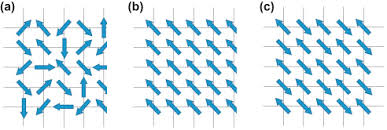
Computer Vision:
- Image reconstruction and restoration
Neuroscience:
- Models of the hippocampus, episodic memory
Pattern completion
Pattern completion
3 - Modern Hopfield networks / Dense Associative Memories
Problem with old-school Hopfield networks
The problems with Hopfield networks are:
Their limited capacity 0.14 \, N.
Ghost patterns (reversed images).
Spurious patterns (bad separation of patterns).
Retrieval is not error-free.
In this example, the masked Homer is closer to the Bart pattern in the energy function, so it converges to its ghost pattern.

Problem with old-school Hopfield networks
- The problem comes mainly from the fact the energy function is a quadratic function of the dot product between a state \mathbf{y} and the patterns \mathbf{y}^k:
E(\mathbf{y}) \approx -\frac{1}{2 P} \, \sum_{k=1}^P ((\mathbf{y}^k)^T \times \mathbf{y})^2
-((\mathbf{y}^k)^T \times \mathbf{y})^2 has minimum when \mathbf{y} = \mathbf{y}^k.
Quadratic functions are very wide, so it is hard to avoid overlap between the patterns.

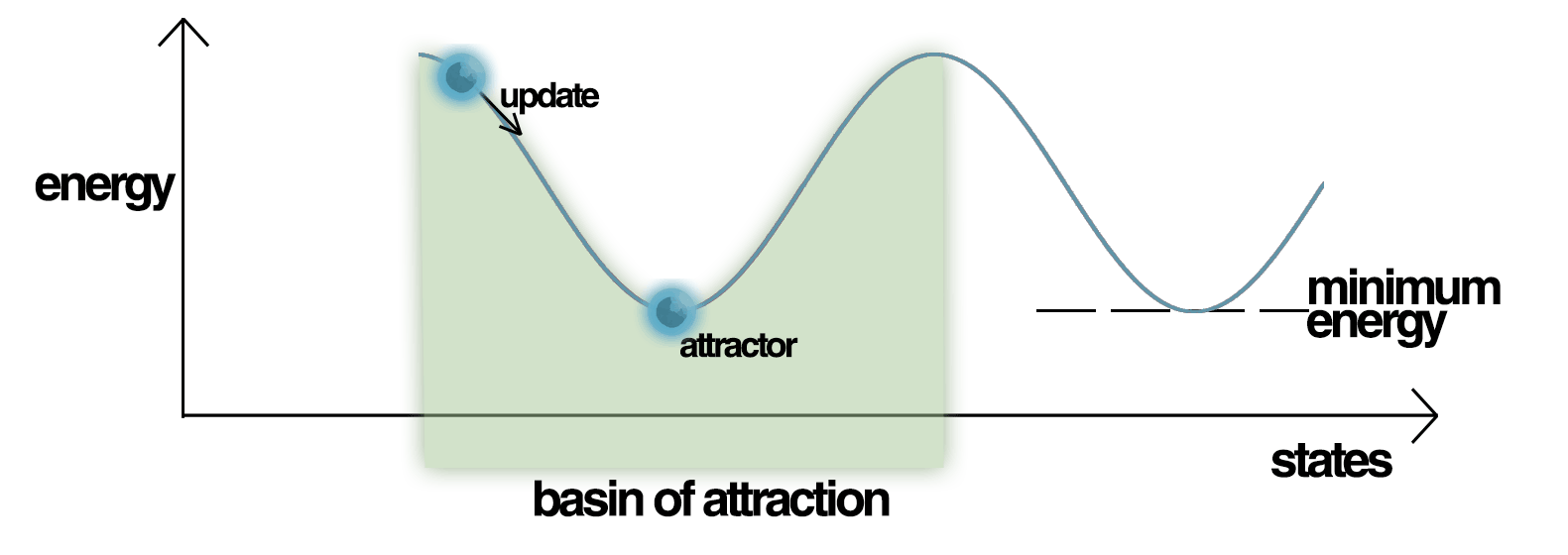
- If we had a sharper energy functions, could not we store more patterns and avoid interference?
Modern Hopfield networks
- Yes. We could define the energy function as a polynomial function of order a> 2 (Krotov and Hopfield, 2016):
E(\mathbf{y}) = -\frac{1}{P} \, \sum_{k=1}^P ((\mathbf{y}^k)^T \times \mathbf{y})^a
and get a polynomial capacity C \approx \alpha_a \, N^{a-1}.
- Or even an exponential function a = \infty (Demircigil et al., 2017):
E(\mathbf{y}) = - \frac{1}{P} \, \sum_{k=1}^P \exp((\mathbf{y}^k)^T \times \mathbf{y})
and get an exponential capacity C \approx 2^{\frac{N}{2}}! One could store exponentially more patterns than neurons.
- The question is then: which update rule would minimize these energies?
Modern Hopfield networks
- Krotov and Hopfield (2016) and Demircigil et al. (2017) show that the binary units y_i can still be updated asynchronously by comparing the energy of the model with the unit on or off:
y_i = \text{sign}(- E(y_i = +1) + E(y_i=-1))
If the energy is lower with the unit on than with the unit off, turn it on! Otherwise turn it off.
Note that computing the energy necessitates to iterate over all patterns, so in practice you should keep the number of patterns small:
E(\mathbf{y}) = - \frac{1}{P} \, \sum_{k=1}^P \exp((\mathbf{y}^k)^T \times \mathbf{y})
- However, you are not bounded by 0.14 \, N anymore, just by the available computational power and RAM.
Modern Hopfield networks
The increased capacity of the modern Hopfield network makes sure that you store many patterns without interference (separability of patterns).
Convergence occurs in only one step (one update per neuron).
4 - Hopfield networks is all you need

Ramsauer et al. (2020) Hopfield Networks is All You Need. arXiv:200802217
Hopfield networks is all you need
Ramsauer et al. (2020) extend the principle to continuous patterns, i.e. vectors.
Let’s put our P patterns (\mathbf{y}^1, \mathbf{y}^2, \dots, \mathbf{y}^P) in a N \times P matrix:
X = \begin{bmatrix} \mathbf{y}^1, \mathbf{y}^2, \dots, \mathbf{y}^P \end{bmatrix}
- We can define the following energy function for a vector \mathbf{y}:
E(\mathbf{y}) = - \text{lse}(\beta, X^T \, \mathbf{y}) + \frac{1}{2} \, \mathbf{y}^T \mathbf{y} + \beta^{-1} \, \log P + \frac{1}{2} \, M
where:
\text{lse}(\beta, \mathbf{z}) = \beta^{-1} \, \log (\sum_{i=1}^P \exp \beta z_i)
is the log-sum-exp function and M is the maximum norm of the patterns.
- The first term is similar to the energy of a modern Hopfield network.
Ramsauer et al. (2020) Hopfield Networks is All You Need. arXiv:200802217
Hopfield networks is all you need
- The update rule that minimizes the energy
E(\mathbf{y}) = - \text{lse}(\beta, X^T \, \mathbf{y}) + \frac{1}{2} \, \mathbf{y}^T \mathbf{y} + \beta^{-1} \, \log P + \frac{1}{2} \, M
is:
\mathbf{y} = \text{softmax}(\beta \, \mathbf{y} \, X^T) \, X^T
Why? Just read the 100 pages of mathematical proof.
Take home message: these are just matrix-vector multiplications and a softmax. We can do that!
Hopfield networks is all you need
- Continuous Hopfield networks can retrieve precisely continous vectors with an exponential capacity.
Hopfield networks is all you need
The sharpness of the attractors is controlled by the temperature parameter \beta.
You decide whether you want single patterns or meta-stable states, i.e. combinations of similar patterns.
Why would we want that? Because it is the principle of self-attention.
Which other words in the sentence are related to the current word?
Hopfield networks is all you need
- Using the representation of a word \mathbf{y}, as well as the rest of the sentence X, we can retrieve a new representation \mathbf{y}^\text{new} that is a mixture of all words in the sentence.
\mathbf{y}^\text{new} = \text{softmax}(\beta \, \mathbf{y} \, X^T) \, X^T
This makes the representation of a word more context-related.
The representations \mathbf{y} and X can be learned using weight matrices, so backpropagation can be used.
This was the key insight of the transformer network that has replaced attentional RNNs in NLP.
Hopfield layers can replace the transformer self-attention with a better performance.
The transformer network was introduced with the title “Attention is all you need”, hence the title of this paper…
The authors claim that a Hopfield layer can also replace fully-connected layers, LSTM layers, attentional layers, but also SVM, KNN or LVQ…
Additional readings
Hopfield, J. J. (1982) Neural networks and physical systems with emergent collective computational properties. Proc. Nat. Acad. Sci. (USA) 79, 2554-2558.
A video from Geoffrey Hinton himself:
https://www.youtube.com/watch?v=Rs1XMS8NqB4
John J. Hopfield (2007), Scholarpedia, 2(5):1977. http://www.scholarpedia.org/article/Hopfield_network
Chris Eliasmith (2007), Scholarpedia, 2(10):1380. http://www.scholarpedia.org/article/Attractor_network
Slides from Davide Bacciu (Pisa) http://didawiki.di.unipi.it/lib/exe/fetch.php/bionics-engineering/computational-neuroscience/2-hopfield-hand.pdf
